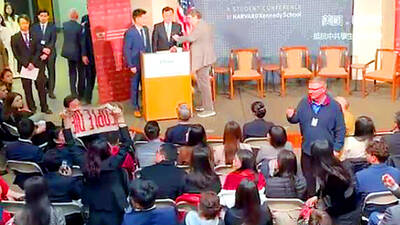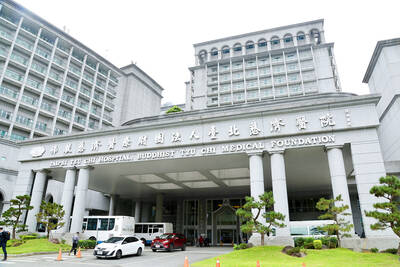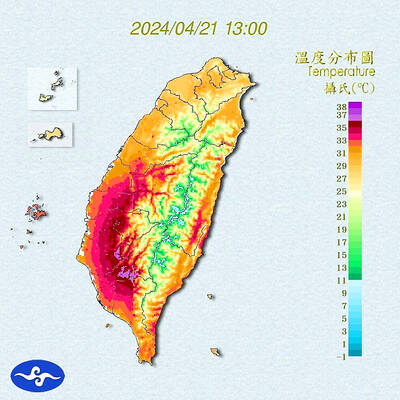A Chinese tourist whose drone crashed after hitting the Taipei 101 building on Tuesday is to be fined NT$300,000 (US$9,538) for breaking the law, the Civil Aeronautics Administration (CAA) said yesterday.
The tourist, Yang Yunfan (楊雲帆), was questioned by aviation police officers on Wednesday night.
Police said the drone had hit the building’s 38th floor, which is about 114m above ground.
The Civil Aviation Act (民用航空法) states that no flying object, including drones, kites, sky lanterns, fireworks and hot air balloons or any other floating object, is allowed to fly above 60m from the elevation of the airport in the area within 6km of the central line of the runway.
The Taipei 101 building is within 6km from the central line of the runway at the Taipei International Airport (Songshan airport), the agency said.
Given the airport’s elevation of 5.5m, no flying object is allowed to fly above 65.5m within the restricted zone, the agency said.
CAA chief secretary Ho Shu-ping (何淑萍) said that Yang had broken the rules on operating floating objects near airports and had been given seven days to respond in accordance with the Administrative Procedures Act (行政程序法).
The Civil Aviation Act states that violators could face fines ranging from NT$300,000 to NT$1.5 million. Since this is a first-time violation, Yang would only be fined NT$300,000, Ho said.
Ho added that the government cannot prevent Yang from leaving the country if he chooses not to pay the fine. However, he would be barred from visiting Taiwan if he fails to do so.
This would be the second time that the agency issues a penalty for people breaking the ban on flying objects near the airport. On Wednesday, the CAA fined a person whose drone was found at the end of the runway at the Songshan airport last month.
In light of the recent incidents, the Executive Yuan convened a meeting yesterday to discuss issues relating to the management of remote-controlled vehicles.
Minister without Portfolio Yeh Shin-cheng (葉欣誠) said that the government should consider all possible uses of drones and the safety issues they might engender from the perspective of national security.
He said that the technology could be applied in disaster relief, crime prevention and for leisure purposes, but it could also be used to threaten aviation and public safety, as well invade personal privacy.
Some people might even turn drones into weapons, making them a major national security concern, he said.
“The fundamental principle is that there should be specific and clear regulations for every possible use of drones,” he said, adding that the CAA, the National Police Agency and the Ministry of Justice should draft relevant regulations and procedures that should be taken under various scenarios.
CAA Director-General Lin Tyh-ming (林志明) said that the government is considering allowing local governments to regulate drones weighing less than 25kg.
Owners of drones weighing more than 25kg would have to register them with the CAA, Lin said.
The first draft of the proposed regulations is expected to be completed by the middle of September, he said.

A group of Taiwanese-American and Tibetan-American students at Harvard University on Saturday disrupted Chinese Ambassador to the US Xie Feng’s (謝鋒) speech at the school, accusing him of being responsible for numerous human rights violations. Four students — two Taiwanese Americans and two from Tibet — held up banners inside a conference hall where Xie was delivering a speech at the opening ceremony of the Harvard Kennedy School China Conference 2024. In a video clip provided by the Coalition of Students Resisting the CCP (Chinese Communist Party), Taiwanese-American Cosette Wu (吳亭樺) and Tibetan-American Tsering Yangchen are seen holding banners that together read:

UNAWARE: Many people sit for long hours every day and eat unhealthy foods, putting them at greater risk of developing one of the ‘three highs,’ an expert said More than 30 percent of adults aged 40 or older who underwent a government-funded health exam were unaware they had at least one of the “three highs” — high blood pressure, high blood lipids or high blood sugar, the Health Promotion Administration (HPA) said yesterday. Among adults aged 40 or older who said they did not have any of the “three highs” before taking the health exam, more than 30 percent were found to have at least one of them, Adult Preventive Health Examination Service data from 2022 showed. People with long-term medical conditions such as hypertension or diabetes usually do not

POLICE INVESTIGATING: A man said he quit his job as a nurse at Taipei Tzu Chi Hospital as he had been ‘disgusted’ by the behavior of his colleagues A man yesterday morning wrote online that he had witnessed nurses taking photographs and touching anesthetized patients inappropriately in Taipei Tzu Chi Hospital’s operating theaters. The man surnamed Huang (黃) wrote on the Professional Technology Temple bulletin board that during his six-month stint as a nurse at the hospital, he had seen nurses taking pictures of patients, including of their private parts, after they were anesthetized. Some nurses had also touched patients inappropriately and children were among those photographed, he said. Huang said this “disgusted” him “so much” that “he felt the need to reveal these unethical acts in the operating theater

Heat advisories were in effect for nine administrative regions yesterday afternoon as warm southwesterly winds pushed temperatures above 38°C in parts of southern Taiwan, the Central Weather Administration (CWA) said. As of 3:30pm yesterday, Tainan’s Yujing District (玉井) had recorded the day’s highest temperature of 39.7°C, though the measurement will not be included in Taiwan’s official heat records since Yujing is an automatic rather than manually operated weather station, the CWA said. Highs recorded in other areas were 38.7°C in Kaohsiung’s Neimen District (內門), 38.2°C in Chiayi City and 38.1°C in Pingtung’s Sandimen Township (三地門), CWA data showed. The spell of scorching